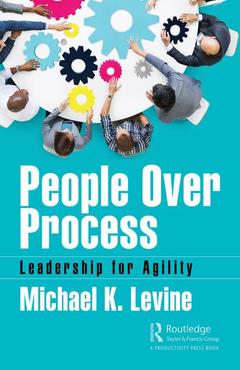Description
People Over Process
Leadership for Agility
Author: Levine Michael K.
Language: English
Subjects for People Over Process:
Keywords
Minimum Viable Product; project planning; Scrum Teams; Agile software development; Business Processes; leadership model; Large Scale Software Development; scrum meeting; CIO; Lean software development; Scrum Master; Daily Scrum; Project Planning Meeting; Scrum Methodology; Agile Coach; Agile Principle; Leadership Tip; User Stories; Architecture Simulations; Agile Manifesto; Agile Team; Facilitative Leadership; Agile Values; Adaptive Process Control; Wall Agenda; Common Language; Production Support Plan; User Experience Manager; Daily Scrum Meeting; Primary Leadership Responsibilities
Publication date: 10-2019
· 15.6x23.4 cm · Paperback
Publication date: 10-2019
· 15.6x23.4 cm · Hardback
Description
/li>Contents
/li>Readership
/li>Biography
/li>
This book helps participants in agile software development environments learn to become leaders. Facilitative leaders should be at every level of the organization, from individual contributor to informal team leader to managers of all stripes -- it takes much focus and intentionality from senior organizational leaders, who have special obligations in creating successful lean and agile development environments. But, beyond the principles of facilitative leadership for agility, People over Process provides tips and demonstrative scenes for the more important and common software meetings: architecture simulations, project planning, team configurations, retrospectives, and more. The author fully illustrates the principles and shares proven techniques for the most important leadership events in agile projects.
While this book focuses on facilitating extraordinarily well-prepared meetings, it serves as a metaphor for leadership more broadly. The leader?s obligation to help their team make rigorous fact-based decisions; to gain broad input and have participants aligned on the outcomes and next steps; and to do so in an efficient way that respects the time of the participants is as relevant to every-day leadership activity as it is to conducting meetings.
The author mixes background and explanation with demonstration -- in this case, the story of an agile project at the fictitious Pacifica Bank. The scenario constructed at Pacifica illustrates the concepts of effective leadership and productive workplace environments. The book concentrates on the flow of software from understanding what is needed through design, development, testing, and deployment.
Essentially, the author provides a simple and powerful model of leadership, examples, and tips. This is not a cookbook on how to lead -- It is a set of principles and examples. All leaders must find their own way for their team, their organization, and their unique challenges.
SECTION 1 Introduction to Facilitative Leadership for Agility Chapter 1 Pacifica: "It’s Not Agile If There Is No Software!" Chapter 2 Background: The Facilitative Leader for Agility Chapter 3 Background: The Organizational Leader for Agility Chapter 4 Pacifica: Mary’s Diagnosis Chapter 5 Background: Extraordinarily Well-Prepared and Conducted Meetings Chapter 6 Pacifica: The Course Correction Meeting SECTION 2 Three Major Frameworks (Architecture, Plan, Team Structure) Chapter 7 Background: Architecture for Agility Chapter 8 Pacifica: The Architecture Simulation Meeting Chapter 9 Background: Project Planning Chapter 10 Pacifica: The Project Planning Meeting Chapter 11 Background: Agile Team Configuration Chapter 12 Pacifica: The Team Configuration Meeting SECTION 3 Background / Pacifica: Routine Meetings Chapter 13 The Daily Scrum Chapter 14 Meeting or Systems Analysis? Chapter 15 Demos Chapter 16 Governance Meetings Chapter 17 Teleconferences SECTION 4 Project Retrospectives Chapter 18 Background: Retrospectives Chapter 19 Pacifica: Project Retrospective




